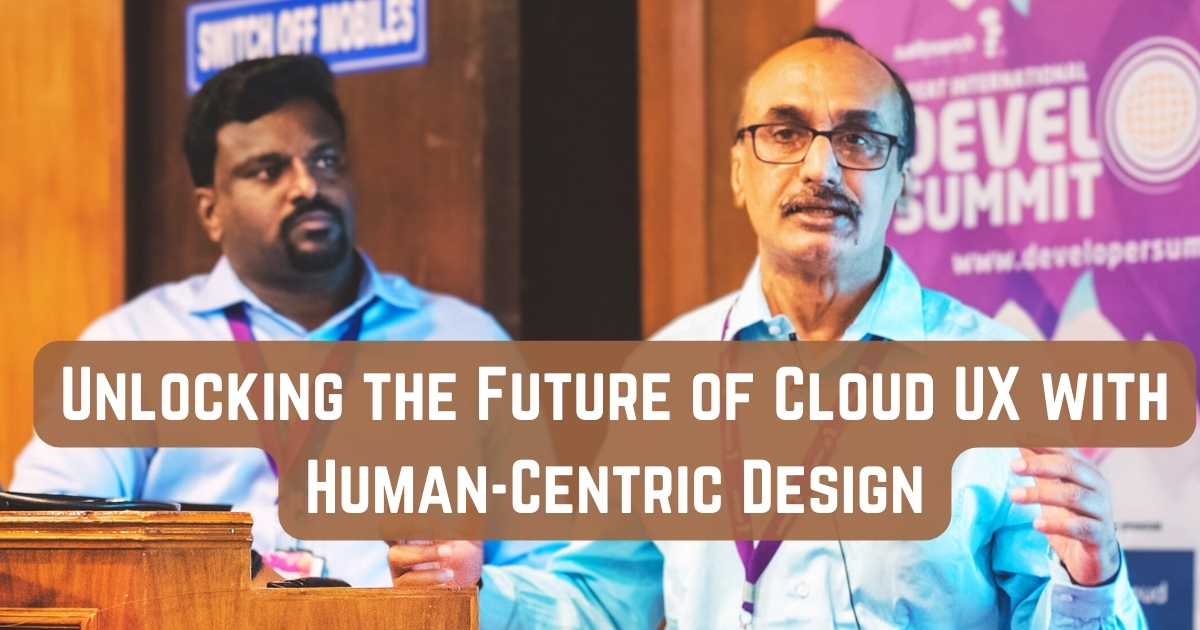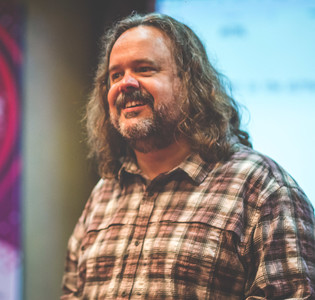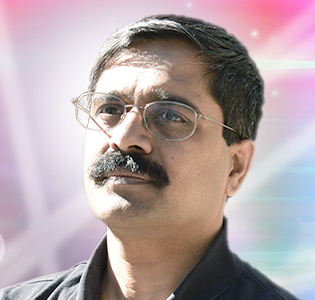
“Once again Saltmarch has knocked it out of the park with interesting speakers, engaging content and challenging ideas. No jetlag fog at all, which counts for how interesting the whole thing was."
Cybersecurity Lead, PwC

The cloud is the backbone of today's digital world, offering a smorgasbord of benefits like scalability, flexibility, and cost savings. But as cloud adoption skyrockets, there's a growing chorus for intuitive interfaces and stellar user experiences (UX). Enter Mridul Moitra and Rakesh Gunasekhar, who recently took the stage at Great International Developer Summit to decode the DNA of Cloud UX and the role of human-centric design in elevating it to the next level.
Rakesh set the stage, diving headfirst into the design thinking process—a critical element for crafting a user-friendly cloud UX. He walked the audience through the five pillars of design thinking: Empathy, Define, Ideate, Prototype, and Test. Each phase, he stressed, is instrumental in grasping customer needs, pinpointing issues, brainstorming with stakeholders, crafting prototypes, and putting them through the usability wringer. In Rakesh's words, this cyclical process is the secret sauce for not just understanding what the customer wants but also for refining the product continually.
But wait, there's more. Rakesh also pulled back the curtain on Design Sprints, a methodology that's like design thinking but on steroids. It includes stages like Discovery, Ideate, Prototype, and Test but adds layers of market dynamics, competitor scrutiny, and risk evaluation. This approach, he contends, is a game-changer for morphing ideas into Minimum Viable Products (MVPs) that can be tested and rolled out with a well-thought-out strategy.
What sets Design Sprints apart is the time-bound nature of the process. Unlike traditional design thinking, which can be open-ended, Design Sprints are typically conducted within a tight timeframe, often just a week. This urgency forces teams to make quick decisions, prioritize features, and focus on the most critical aspects of the user experience. It's a pressure cooker of innovation, but one that yields tangible results quickly. Moreover, Design Sprints incorporate real-world data and user feedback right from the get-go. This data-driven approach ensures that the MVP is not just a product of internal brainstorming but is shaped and refined by actual user needs and market demands. By integrating analytics and user testing into the sprint, teams can immediately gauge the effectiveness of their designs and make data-informed decisions, reducing the risk of launching a product that doesn't resonate with users.
Another unique aspect is the Sprint Retrospective, a post-sprint analysis that allows teams to reflect on what worked, what didn't, and what could be improved in future sprints. This iterative learning is invaluable for continuous improvement and for fostering a culture of innovation and user-centricity. As Rakesh wrapped up his deep dive into the accelerated world of Design Sprints, it became clear that this methodology is not just a tool but a mindset—one that could very well be the catalyst for the next wave of cloud innovation.
And speaking of innovation in the cloud, Mridul took the baton to navigate us through the cloud transformation odyssey, mapping the shift from traditional on-premises setups to the brave new world of multi-cloud ecosystems. He didn't shy away from discussing the initial bumps in the road, particularly around security and scalability. Yet, as cloud services upped their game, offering robust solutions for high availability, disaster recovery, and global scalability, businesses started making the leap en masse.
Here's where the conversation gets even richer. Cloud computing isn't just about storage and scalability; it's also a pivotal tool for UX/UI designers. Features like on-demand self-service and vast network access significantly improve the UX/UI design process. Real-time collaboration among UX/UI designers, web developers, and other team members becomes a breeze, ensuring an effective design process and faster decision-making. Cloud-based software allows designers to work from multiple devices, offering scalability that is not constrained by local hardware. Furthermore, cloud computing provides platforms and resources for designers to create and host interactive prototypes, enabling real-time user testing and feedback collection.
Mridul also spotlighted Cloud Native Applications, the next-gen software designed to milk every ounce of the cloud's capabilities. These apps, he emphasized, need to tick boxes for global accessibility, reliability, security, and manageability. And let's not forget the role of cutting-edge tech like analytics, blockchain, and AI in keeping your cloud offerings not just relevant but ahead of the curve.
The conversation then veered towards the marriage of UX practices with cloud applications—a topic close to Mridul's heart. He argued that a top-notch UX isn't just a nice-to-have; it's a business imperative for client retention. However, he didn't gloss over the hurdles, notably the isolated worlds of developers and UX designers. This disconnect, he warned, can be a stumbling block in delivering what end-users genuinely crave.
But Mridul didn't stop there. He delved into the transformative power of cloud-based UX tools that facilitate real-time collaboration and version control. These tools, often integrated directly into cloud platforms, allow for a more fluid exchange of ideas and quicker iterations, bridging the gap between developers and designers.
Cloud platforms have also improved security protocols to protect sensitive design assets and information while being shared among team members, adding another layer of value to the cloud-UX marriage. Moreover, the cloud enables A/B testing on a grand scale, allowing teams to collect extensive user feedback for data-driven decision-making. This not only enhances the user experience but also contributes to building a more robust and secure application.
As Mridul concluded his insights into the symbiotic relationship between cloud and UX, it was evident that the future lies in the seamless integration of these two domains. And this brings us to the grand finale of their discourse.
To wrap things up, both Mridul and Rakesh championed a unified approach that melds DevOps, security, and UX design into a cohesive strategy for delivering an unparalleled cloud user experience. This synergy, they claim, is the linchpin for digital transformation, enabling businesses to not only meet but exceed stakeholder expectations while staying ahead in the digital race.
So, if you're in the business of cloud or UX design, the insights from Mridul Moitra and Rakesh Gunasekhar are nothing short of a masterclass in human-centric design for the cloud. Their roadmap offers a robust framework for those aiming to elevate user experience in cloud settings, setting the stage for enhanced client loyalty and a competitive edge in a constantly changing digital world.
Have questions or comments about this article? Reach out to us here.
Banner Image Credits: (From Left to Right) Rakesh Gunasekhar and Mridul Moitra at Great International Developer Summit

“Once again Saltmarch has knocked it out of the park with interesting speakers, engaging content and challenging ideas. No jetlag fog at all, which counts for how interesting the whole thing was."
Cybersecurity Lead, PwC

“Very much looking forward to next year. I will be keeping my eye out for the date so I can make sure I lock it in my calendar."
Software Engineering Specialist, Intuit

“Best conference I have ever been to with lots of insights and information on next generation technologies and those that are the need of the hour."
Software Architect, GroupOn

“Happy to meet everyone who came from near and far. Glad to know you've discovered some great lessons here, and glad you joined us for all the discoveries great and small."
Web Architect & Principal Engineer, Scott Davis

“Wonderful set of conferences, well organized, fantastic speakers, and an amazingly interactive set of audience. Thanks for having me at the events!"
Founder of Agile Developer Inc., Dr. Venkat Subramaniam

“What a buzz! The events have been instrumental in bringing the whole software community together. There has been something for everyone from developers to architects to business to vendors. Thanks everyone!"
Voltaire Yap, Global Events Manager, Oracle Corp.